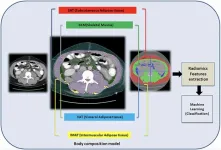(Press-News.org) University of Houston psychology researcher Jason Griffin, who has pioneered new ways of measuring eye movements to understand autism spectrum disorder, is reporting that children with autism focus on faces differently than other children, especially in the early stages of visual processing. His findings may lead to improvement in face processing for those with the neurodevelopmental condition.
For most people, looking eye-to-eye with someone while talking seems an important yet innocuous social convention – one barely thought of during polite conversation. But for those with autism, characterized by differences in social communication, including reduced facial recognition, the struggle is real.
“In this study, our primary goal was to test the hypothesis that children with autism display qualitatively distinct eye movement patterns during social perception,” reports Griffin in Biological Psychiatry.
Griffin utilized new analytic techniques to assess and compare the looking behavior in a large group of autistic and neurotypical children as they viewed social images.
They found that children with autism prioritize faces in different ways, particularly when they first see them.
“Our analysis supported the existence of two eye movement patterns that emerged across three social perception assays,” said Griffin. “A focused pattern was characterized by small face regions of interest that captured looking immediately. In contrast, an exploratory pattern was characterized by larger face regions of interest that included nonsocial objects and did not capture looking immediately”
Researchers found that autistic children were more likely to use this explorative method compared to the focused eye movement pattern. Decreased likelihood of precisely looking at faces early in visual processing may be an important feature of autism that is associated with autism-related symptomology and may reflect less visual sensitivity to face information.
Griffin’s inspiration
This is not Griffin’s first foray into the world of autism research. He’s been at it for many years, spending five of those years working on a team to develop a computer-based intervention game for autistic adolescents to play. It’s designed to change their eye movements to improve their perception of where another person is looking.
Griffin’s inspiration for all his pioneering research came from home, spurred on by growing up with an autistic brother.
“My brother and I have always been best friends. We grew up together, rode bikes together and played video games together,” said Griffin in a recent article published in Science. “As children, he did not speak or make eye contact much and struggled to interact socially. I do not remember exactly when I knew my brother had autism, but I knew we would be best friends forever because he was my younger brother.”
Griffin’s commitment and contributions to autism research made him a finalist for the prestigious NOMIS & Science Young Explorer Award, which recognizes young scholars who are exceptionally bold and innovative in their approach to scientific inquiry. He will be recognized for this award at University of Zurich in Switzerland.
The real world
In the Griffin lab, with real life as his mentor, Griffin is progressing a line of science he calls naturalistic neuroscience - basically taking things out of the lab into the real world.
“We have kids come in, they look at a computer screen that has pictures of faces or social scenes, and we assess how long they look at the face or the eyes,” said Griffin. “This is great science. don’t get me wrong, but there is an opportunity to explore how some of these processes play out in real world situations.”
With recent funding from the Autism Science Foundation, Griffin is exploring how we can use mobile eye-tracking technology to understand how autistic children look at faces in real world situations, like during a face-to-face conversation.
“There’s so much that's different about being in front of another human. And ultimately, that’s where autistic people and everyone else lives—in the real world,” said Griffin.
END
Eyes on the brain at the University of Houston
Eye movements help understand facial processing in children with autism
2024-12-09
ELSE PRESS RELEASES FROM THIS DATE:
Astronomers find the smallest main-belt asteroids ever detected
2024-12-09
The majority of the known asteroids orbit within the main asteroid belt located between Mars and Jupiter at an average distance from Earth of about 250 millions kilometers. Since the discovery of the first asteroid in 1801, nearly 750.000 of them have already been numbered, mainly in the last decade thanks to the many optical surveys searching the sky every clear nights. Most of these asteroids are larger than 1 kilometer, the largest one, Vesta, at about 530 km in diameter, while many millions of smaller ones are expected. While these look huge numbers, the total mass of all the asteroids combined is less than that of Earth's Moon.
Sometimes, these asteroids ...
Mays Cancer Center hosts 47th San Antonio Breast Cancer Symposium, highlighting advances in treatment and care
2024-12-09
SAN ANTONIO, Dec. 9, 2024 – Mays Cancer Center at The University of Texas Health Science Center at San Antonio (UT Health San Antonio), in partnership with the American Association for Cancer Research (AACR), is hosting the 47th annual San Antonio Breast Cancer Symposium at the Henry B. Gonzalez Convention Center on Dec. 10-13.
Owned and initiated by Mays Cancer Center, the San Antonio Breast Cancer Symposium is the world’s largest breast cancer research conference. More than 11,000 clinicians, researchers, and patient ...
CT radiomics and body composition for predicting hepatic decompensation
2024-12-09
“This study reveals the potential for prognostic features in predicting hepatic decompensation in patients with PSC.”
BUFFALO, NY – December 9, 2024 – A new research paper was published in Oncotarget’s Volume 15 on November 22, 2024, entitled “Computed tomography-based radiomics and body composition model for predicting hepatic decompensation.”
Mayo Clinic researchers Yashbir Singh, John E. Eaton, Sudhakar K. Venkatesh, and Bradley J. Erickson have developed an innovative AI tool to predict hepatic decompensation in individuals with primary sclerosing cholangitis (PSC). PSC is a chronic disease that damages ...
Loneliness and social isolation among US older adults
2024-12-09
About The Study: This study found that adults ages 50 to 80 commonly reported loneliness and social isolation. While the pandemic disrupted social connections, rates of loneliness and isolation were substantial both before and after the early pandemic. High rates of loneliness and social isolation occurred in several sociodemographic groups, especially those with self-reported fair or poor physical or mental health.
Corresponding Author: To contact the corresponding author, Preeti N. Malani, MD, MSJ, email pmalani@umich.edu.
To access the embargoed study: Visit our For The Media website at ...
Loneliness and isolation: Back to pre-pandemic levels, but still high, for older adults
2024-12-09
Loneliness and isolation among older Americans have mostly returned to pre-pandemic rates, but that still means more than one third of people age 50 to 80 feel lonely, and nearly as many feel isolated, a new national study shows.
And some older adults – especially those dealing with major physical health or mental health issues – still have much higher rates of loneliness and social isolation than others.
The new findings, from a review of six years of data from the National Poll on Healthy Aging, are published in JAMA by a team from the University of Michigan Institute for Healthcare Policy and Innovation.
Starting ...
MIT astronomers find the smallest asteroids ever detected in the main belt
2024-12-09
The asteroid that extinguished the dinosaurs is estimated to have been about 10 kilometers across. That’s about as wide as Brooklyn. Such a massive impactor is predicted to hit Earth rarely, once every 100 million to 500 million years.
In contrast, much smaller asteroids, about the size of a bus, can strike Earth more frequently, every few years. These “decameter” asteroids, measuring just tens of meters across, are more likely to escape the main asteroid belt and migrate in to become near-Earth objects. ...
Health and lifestyle factors and dementia risk among former professional soccer players
2024-12-09
About The Study: This cohort study found no evidence that high dementia risk among former professional soccer players was associated with potentially modifiable general health and lifestyle dementia risk factors. These data support continuation of measures directed toward reducing exposure to repetitive head impacts and traumatic brain injury in sport.
Corresponding Author: To contact the corresponding author, William Stewart, MBChB, PhD, email william.stewart@glasgow.ac.uk.
To access the embargoed study: Visit our For ...
Stress-related disorders among young individuals with surgical removal of tonsils or adenoids
2024-12-09
About The Study: The findings of this cohort study suggest that early-life surgical removal of tonsils or adenoids is associated with a higher future risk of stress-related disorders and highlight a need to understand the role of adenotonsillar diseases or associated health conditions in the development of stress-related psychiatric disorders.
Corresponding Author: To contact the corresponding author, Zhe Zhang, MD, PhD, email zhangzhe@gxmu.edu.cn.
To access the embargoed study: Visit our For ...
RSV disease burden and nirsevimab effectiveness in young children from 2023-2024
2024-12-09
About The Study: This analysis documented the continued high burden of medically attended respiratory syncytial virus (RSV)-associated acute respiratory illness among young children in the U.S. Nirsevimab and maternal RSV vaccine uptake was low, but nirsevimab was effective against RSV-associated hospitalization. There is a potential for substantial public health impact with increased and equitable prevention product coverage in future seasons.
Corresponding Author: To contact the corresponding author, Heidi L. Moline, MD, MPH, email ick6@cdc.gov.
To access the embargoed study: Visit our For The Media website at this link https://media.jamanetwork.com/
(doi:10.1001/jamapediatrics.2024.5572)
Editor’s ...
Brain tumor organoids accurately model patient response to CAR T cell therapy
2024-12-09
PHILADELPHIA— For the first time, researchers used lab-grown organoids created from tumors of individuals with glioblastoma (GBM) to accurately model a patient’s response to CAR T cell therapy in real time. The organoid’s response to therapy mirrored the response of the actual tumor in the patient’s brain. That is, if the tumor-derived organoid shrunk after treatment, so did the patient’s actual tumor, according to new research from the Perelman School of Medicine at the University of Pennsylvania, published today in Cell Stem Cell.
“It’s hard to measure how a patient with GBM responds to treatment because we can’t regularly ...
LAST 30 PRESS RELEASES:
NASA’s Webb telescope finds bizarre atmosphere on a lemon-shaped exoplanet
The gut bacteria that put the brakes on weight gain in mice
Exploring how patients feel about AI transcription
Category ‘6’ tropical cyclone hot spots are growing
Video: Drivers struggle to multitask when using dashboard touch screens, study finds
SLU research shows surge in alcohol-related liver disease driving ‘deaths of despair’
Rising heat reshapes how microbes break down microplastics, new review finds
Roots reveal a hidden carbon pathway in maize plants
Membrane magic: FAMU-FSU researchers repurpose fuel cells membranes for new applications
UN Member States pledge to increase access to diagnosis and inhaled medicines for the 480 million people living with COPD
Combination therapy shows potential to treat pediatric brain cancer ATRT
Study links seabird nesting to shark turf wars in Hawai‘i
Legal sports betting linked to sharp increases in violent crime, study finds
Breakthrough AI from NYUAD speeds up discovery of life-supporting microbes
New Eva Mayr-Stihl Foundation funding initiative boosts research at University of Freiburg on adaptation of forests to global change
The perfect plastic? Plant-based, fully saltwater degradable, zero microplastics
Bias in data may be blocking AI’s potential to combat antibiotic resistance
Article-level metrics would provide more recognition to most researchers than journal-level metrics
Satiety’s little helper: Protein that supports appetite regulating protein identified
UF dives deep into predicting storm damage with computer models
A stormy ocean voyage yields insights on the global carbon cycle
Scientists identify first non-coding gene that controls cell size
Demonstration of altermagnetism in RuO₂ thin films -- A new magnetic material for the AI era
Penn researchers awarded $25M to conduct trial using smartphones to fight heart disease
PCORI awards funding for new patient-centered healthcare research
Exploring the origins of the universe: 145 low-noise amplifiers complete ALMA telescopes
Empress cicada wings help illuminate molecular structure
Using sound waves to detect helium
Time burden in patients with metastatic breast and ovarian cancer from clinic and home demands
Researchers discover bias in AI models that analyze pathology samples
[Press-News.org] Eyes on the brain at the University of HoustonEye movements help understand facial processing in children with autism




